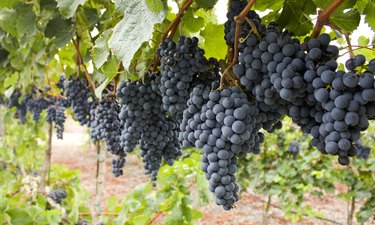
Grapevines (Vitis vinifera, USDA plant hardiness zones 3 to 10b) may be good for wine, but they can also be very invasive in certain parts of the country. This is especially the case with wild grapevines. Sometimes, it is necessary to kill grapevines because they can often harm or even kill other trees and plants. In areas like New York's Hudson Valley, the tangled vines hang down over bushes and trees, weighing down their victims until they break. This is not only a nuisance but it can be dangerous for humans and animals living nearby.
How to Kill Grapevines
Video of the Day
Wild grapevines need a decent amount of sunshine to grow properly. These plants have large root systems, but you can cut the vines and then cover up the stem ends to prevent them from getting sun. Alternatively, you can cut the stems and then dig out the roots, but again, the roots can be quite large.
Video of the Day
The most reliable method to kill grapevines is to use an herbicide. This is best done in the fall because that is the time of year when wild grapevines pull nutrients into their roots before slumbering for the winter. Choose herbicides that have triclopyr or glyphosate and get a heavy-duty pair of garden shears ready.
Cut the vines at the beginning of the stems, and you can then treat the cut ends with the herbicide. Be extra careful not to get any herbicide on anything else other than the vines. If it gets on trees, it could damage or kill them.
Benefits of Wild Grapes
Not all wild grapes are bad, and some are actually quite tasty. Wild grapes differ from domesticated grapes, and they are found on river banks, atop tree canopies and along fences and roadsides. They have no trunks, and birds love to eat all parts of these plants.
These grapes start out as small white flowers, which then form into hard green grapes by midsummer. In late summer, they turn purplish-black. Wild grapes are used to make wine, juice, raisins and jam. Check with your local garden center before consuming a plant you believe to be wild grapes just to be sure that you have properly identified the plant.
More About Wild Grapes
Despite the benefits of wild grapes to both humans and wildlife, the plants can be quite a nuisance. They are classified as perennial trailing or climbing vines, which can overtake other plants and wreak havoc on landscaping. The leaves of wild grape plants are large, with veins that extend like fingers, and they have grapes that are smaller than the ones you might find in the grocery store. These plants reproduce by seeds and sprout when cut unless treated with herbicides.
Wild grapevine roots can live for many years, and the stems have brown bark that falls off in strips. They generally bloom in late spring to early summer, with berries forming in late summer until the frost arrives. The fruit is eaten by birds and animals, who disperse the seeds. These vines are known to climb up and over trees, blocking the light, robbing them of nutrients and weighing them down.